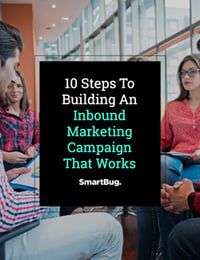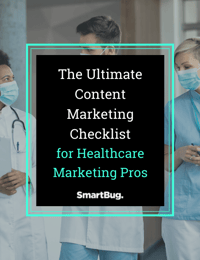
8 Things to Include in Every Healthcare Marketing Plan
April 10, 2018
Are you responsible for creating a marketing plan for a healthcare organization and feeling a bit overwhelmed? With such a large industry, it can be difficult to decide where to focus your efforts.
To help you get started, below is a list of items beyond the standard SWOT to include in your healthcare marketing plan and put you on the track to success.
- Product and Services Audit
- Clearly Defined Buyer Personas
- S.M.A.R.T. Business, Marketing, and Sales Goals
- Sales Process and Lead Identification Overview
- Current Marketing Summary and Gap Analysis
- Campaign Foundations
- Your Recommended Strategy
- Your SMEs
1. Product and Services Audit
I cannot stress this enough: Know your products and services front and back. Your marketing will be much better—and your life much less stressful—if you know the ins and outs of your products and services. Create a matrix that aligns the product with the buyer persona. Who uses the products and services you offer? Why do they need it? What problems do the products and services solve? By ensuring you have a clear understanding of exactly what you’re offering, you’ll be better able to market it more effectively.
2. Clearly Defined Buyer Personas
Knowing your buyer personas can make or break your marketing efforts. Be sure to define them in your plan. Do your homework. Talk to your existing customers. Review current marketing trends and see where your website visits and customers are coming from. Read industry news. Do what you can to know who these people are, and then create the persona. This persona is the audience your plan should target and it should affect your messaging, visual assets, and every other piece of your marketing efforts.
Remember, it is extremely important that you hone in on your specific area of healthcare and learn your niche. Get specific with your research and know who you are targeting.
3. S.M.A.R.T. Business, Marketing, and Sales Goals
SMART is an acronym standing for specific, measurable, attainable, relevant, and timely. When you start to create goals for marketing, or when you get information from team members about business goals, make sure they are SMART. For example, a marketing goal may be that you want to increase leads. Simply stating that you want more leads isn’t enough. A SMART goal would be: Increase inbound leads by 13 percent MoM by the end of 2018. Not only are SMART goals easier to track, but they help others understand exactly what you’re trying to achieve and how your tactics can make the goal a reality.
In addition to having SMART goals, you should also be sure that you’re segmenting goals. Your goals should be broken down into the following:
Business Goals
Business goals (what the entire company hopes to achieve) are important to know so that you can see the bigger picture. What is marketing doing this year that can help move the needle for the company? Having this information will help prove the ROI of your efforts.
Marketing Goals
When creating SMART marketing goals, you may need to break them down into other components. For example, what do you hope to achieve with inbound marketing? How do these goals differ from your traditional, outbound marketing efforts? Do you have goals for a specific channel? More webinars maybe? More blogging? All of these goals need to be included in your marketing plan so that you know where to focus your resources.
Sales Goals
When marketing helps the sales team fill their funnel with qualified leads, everybody wins, so understand the needs of the sales team, what numbers they need to hit, how long the sales cycle is from lead to customer/patient, what support materials are needed, and so on. Once you know these things, you can include tactics in your marketing plan to help meet those needs.
4. Sales Process and Lead Identification Overview
As mentioned above, you need to have a clear understanding of how your marketing efforts currently tie in with your sales team’s efforts. When developing your healthcare marketing plan, get into details about the sales process. Include buyer pain points, best lead sources, why customers buy, common sales objections, and an overview of the buying process. It’s also helpful for marketers to sit in on sales calls.
Along with these things, you should agree upon lead identification requirements (what defines a marketing qualified lead, what defines a sales qualified lead). This will ensure that both teams are on the same page when it comes to leads and objectives.
5. Current Marketing Summary and Gap Analysis
A gap analysis assesses your current marketing efforts and defines what you need to do to achieve your desired outcomes. Take a look at the current approaches you’re taking to gain customers and then do an analysis of your website and see what can be improved. Look at what your competitors are doing that you could do better. The gap analysis will help you dictate your strategy for the year because it will identify many areas of opportunity.
6. Campaign Foundations
Before you get into the meat of your marketing plan, lay the foundations you need in order to complete the tactics in your strategy. Identify your marketing software. Set up social accounts. Create email templates. The list goes on, but you get the idea.
7. Your Recommended Strategy
What we’ve all been waiting for! The meat and potatoes of your plan. Your strategy should be specific. If you’re blogging (which you should be), have your first set of titles and targeted keywords in the plan. Know the content you’ll be developing throughout the year and how you are going to promote it. Put together high-level strategies and then get into specifics of how you’ll pull it off. Explain the how and why based on your research.
8. Your SMEs
Knowing who your subject matter experts (SMEs) are will help to move things along once your campaign kicks off. They will be your go-to people when technical pieces of content need to be written and reviewed. Identifying a few key experts that are comfortable talking to the media is also useful in advancing your PR efforts.
When it comes to the healthcare industry, the most important thing to keep in mind is to be specific and know exactly who it is that you are targeting. With a smaller niche, the odds of people engaging with your company go up significantly.
Originally written on February 10, 2015. Content was updated April 10, 2018.

About the author
J'Neal Hachquet was formerly a Marketing Strategist at SmartBug Media. She has over 16 years of professional marketing experience in a variety of industries. J’Neal is both creative and analytical, with a bachelor’s degree in marketing and an MBA from the University of Nevada. Read more articles by J'Neal Hachquet.











